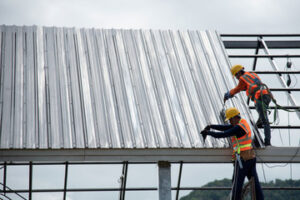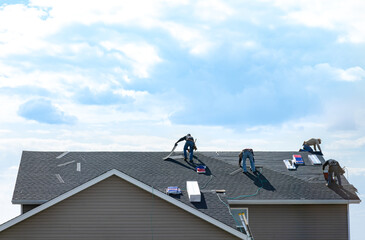Residential Roof Repair
Residential Roof Repair Las Vegas NV involves a wide range of issues that affect your home’s roof. Your roof protects your belongings and prevents pests from invading your home, so it’s important to keep up with maintenance and repair issues.
Identifying problems early can help you avoid expensive fusture repairs or even a roof replacement. Fortunately, many roofing issues are easily repairable.
Moisture is a common problem that can cause significant damage to any building structure, including the roof. There are a few different ways moisture can get into a home and it is important to recognize the signs so it can be addressed quickly and effectively.
Whether you have a leak or condensation, both are problematic for your roofing system. While water stains or drips on the ceiling indicate a leak, condensation is more subtle. It may be as simple as noticing moisture on windows and mirrors, or it can be more significant, such as visible mold in the attic or around windows, buckling shingles or damp areas on walls.
The presence of a vapor barrier in the attic helps to keep moisture from entering the living spaces of the home and causing water damage. However, if the barrier is damaged or ineffective, then it will be possible for moisture to build up in the attic and damage the wood framing of the roof. This can lead to rot, which will eventually compromise the structural integrity of the roof.
Condensation in the attic happens when warm air rises from the interior of a home and comes into contact with the cool underside of the roof surface. As the warm air cools, it causes the water vapor to condense into liquid form. This moisture can drip down the side of the attic and into the living space below, causing wood rot and other problems.
Humid weather conditions, lack of ventilation in the attic and other factors can increase the likelihood of condensation forming on the roof. Showering, cooking and other household activities introduce moisture into the air and can contribute to attic condensation. A lack of adequate insulation also increases temperature differences between the attic and the interior living space, which can risk condensation.
The presence of moisture can be difficult to detect in the attic because it typically appears as dark spots on the ceiling. It can also show up in the form of dripping water, wet insulation, spatter marks on the attic floor and rust on electrical outlets or switches. A professional roof inspection will help identify potential sources of trapped moisture and determine how to fix the problem.
Sagging
A sagging roof is a major issue that should never be ignored. This structural concern is a sign of insufficient support and can lead to expensive repairs, damage within the home, and serious safety issues. In some cases, sagging can even cause the collapse of the entire roof.
Fortunately, there are many solutions for sagging roofs that can help prevent these structural problems and improve your home’s safety. Proper construction and regular inspections are essential to spotting potential issues before they develop. This can include the addition of extra supports, sistering rafters, and reinforcing trusses. These can help strengthen and distribute the weight of the roof and prevent it from becoming overloaded with snow, debris, or excessive roofing materials.
One of the most common signs that a residential roof is beginning to sag is visible dips or curves in the roofline and ridge. This unevenness may be apparent from the street or from inside the house. If you notice any sagging, it’s important to call a professional as soon as possible.
In some cases, sagging roofs may be the result of framing and structural errors. This can be due to construction mistakes during initial building or modifications that fail to adhere to strict structural standards. In these cases, a roofing contractor will need to inspect the structure and make necessary repairs. This may involve the addition of new rafters, redistributing the weight of the roof, and replacing rotten or pest-damaged wood.
While a sagging roof can be caused by many different factors, most sagging problems are related to inadequate structural support. This can be the result of poor construction, a lack of maintenance, or environmental conditions like heavy snow and water accumulation.
While sagging isn’t an immediate threat to the structural integrity of your home, it should always be addressed as soon as possible. Putting off this repair can lead to higher repair costs and serious structural damage that may compromise the safety of your family. It can also affect your home’s value and appearance. If you’re concerned about a sagging roof, call a roofing professional today to learn more about the best solutions for your needs.
Flashing Issues
Flashing is the waterproof barrier that safeguards vulnerable areas of your roof, like chimneys, skylights, vents, and other protrusions. If your flashing is damaged, you could be facing leaks and structural damage.
Often, flashing problems don’t reveal themselves until there’s already significant water damage inside your home. Depending on the severity of the problem, you may find yourself dealing with damp insulation, mold growth, or rotted wood. Thankfully, there are some warning signs you can look for.
Check for flashing damage such as rust, cracks, or missing pieces. Also check for any gaps where the flashing meets a wall or other protrusion. If you notice any of these issues, it’s time to call in the experts.
Your roof takes a beating from rain, snow, and wind. While flashing is designed to withstand these elements, it can wear down over time due to age and exposure.
Even if you don’t have any obvious leaks, there are still several warning signs to keep an eye out for. Look for rust on the flashing, which can weaken it and allow moisture to penetrate. You should also watch for sagging or loose shingles around the flashing area, which can cause further damage.
If you do see any leaking water spots, be sure to inspect your attic and ceiling for the source of the problem. If the leak is caused by damaged flashing, it could be a sign that there are other leaks throughout the house.
The best way to protect your roof from flashing issues is to conduct regular inspections with a professional. They’ll be able to identify the source of any issues and recommend the appropriate repair services.
Keeping your roof in top condition is an investment in the longevity and safety of your home. With proper maintenance, you can avoid costly repairs down the line and keep your home safe, dry, and comfortable through all seasons. For the best results, choose a local roofing contractor with extensive experience handling various weather conditions in your region. By choosing a locally owned and operated roofing company, you can save money without compromising on quality or service.
Shingle Issues
Shingles can get damaged in a variety of ways, including aging, extreme weather conditions, and improper installation. These problems increase the risk of leaks and can lead to interior damage. A qualified roofing contractor can evaluate the condition of shingles and recommend replacement as needed.
A homeowner should look for a variety of signs that the roof needs repair or replacement. These include curling, cracking, buckling, and missing shingles. Also look for shingle flashing that requires attention, such as the flashing around chimneys, vents, and skylights, which is often made of tar or roof cement and should be replaced with metal to prevent leaks.
Other shingle issues to watch for include granule loss and blistering. Granule loss occurs when the shingles lose their protective coating, usually due to aging or exposure to harsh weather. Blistering, on the other hand, appears as bubbles on the surface of a shingle and is caused by trapped moisture. In both cases, prompt shingle replacement will minimize the problem.
Another common shingle issue is the growth of algae and mold. This is an indication that the shingle material does not provide the level of weather resistance and fire protection it was designed for, and should be considered as an option for a full roof replacement.
It is also important to keep in mind that a residential roof should be inspected regularly, at least twice a year and after severe weather events. Regular inspections can mitigate long-term shingle damage and ensure the safety of the home’s occupants. A professional roofing contractor can check shingles for uniformity, secure placement, and intact granules. They can also inspect the flashing, ensuring it is sealed and not corroded and that the shingle materials used match the roof design. They can also clean gutters to prevent debris from trapping water on the roof and causing damage. Finally, they can check for leaks and other visible problems, such as water stains on the ceiling or walls that may indicate a roof leak that will require prompt action to prevent further interior damage. Taking care of these issues will help to extend the longevity of an asphalt shingle roof.

